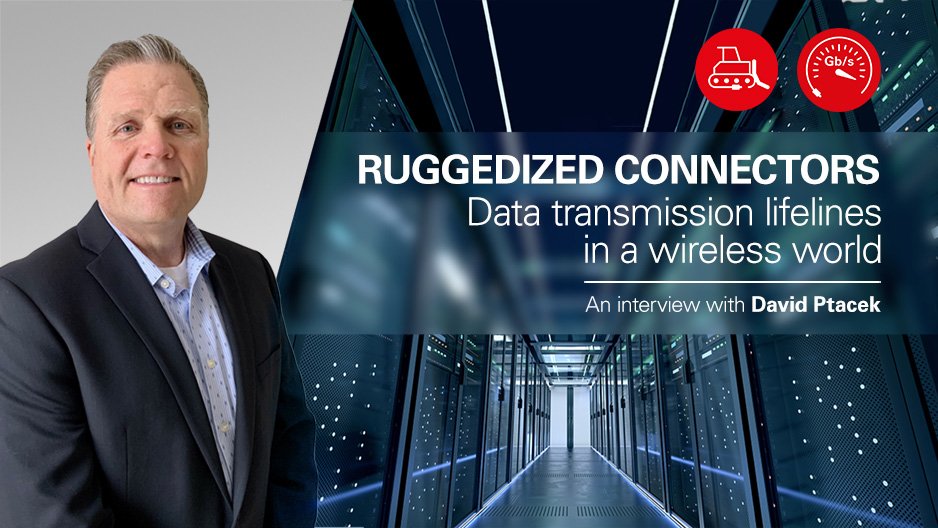From a soldier sending his position in a battle to a doctor needing vital patient information during an operation to an oil rig operator needing constant reports on the operational health of the platform, the ability to capture and transmit data has taken on new forms.
As his company prepares to manage the next generation of data, David Ptacek, Director of Sales for Fischer Connectors in the Americas, says data reliability and data speed are the two most important qualities his customers look for in the vital world of ruggedized connectors.
“It’s about the data,” Ptacek says. “The faster the data, the higher the data rate. We’ve gone from USB 2.0 to USB 3.2 Gen 2. We now have faster Ethernet speeds, and Gigabit speeds. If we think personally about what device each of us has, all those connectors are on the inside. Fischer Connectors plays on the outside of the boxes.”
That includes understanding both common needs (Fischer Connectors has 65,000 SKUs in its inventory) to specific custom needs for medical, military or industrial applications in a changing world. “One of the things we do for a custom project is we use a checklist,” Ptacek explains. “What’s the application? What’s the temperature? Are there special sealing environments? Defining the specific connector or connectivity solution needed all comes down to the application.”
The emergence of wireless connectors doesn’t mitigate the need for rugged connections. In fact, a ruggedized connection in a wireless environment is even more important. Connectors are needed in the system that is worn, while the connected wearable system communicates to a remote part of the ecosystem. According to an IDC study, there were roughly 113 million wearable devices shipped in 2017; by 2021, that market is expected to almost double to 222.3 million shipments.
A recent Fischer Connectors study on wearable connectivity notes, “The use of smart wearables is becoming increasingly widespread. The price of components has also been falling. Moreover, the use of new materials, designs, energy storage and scavenging technologies, and of new production techniques, is driving improvements in performance, functionality and usability.”
That puts even more emphasis on finding the intersection between innovative use and unfailingly reliable operation, particularly in rugged applications.
“Today it’s about size, weight and power,” Ptacek says. “Everybody wants everything smaller, lighter and to handle more power. You need to be able to use power, data and video through one connector rather than three connectors.”
The ability to carry multiple signals through a single cable increases the opportunity to provide effective data management in a smaller footprint. It also rachets up the need for that signal – whether power, data or video – to be online at all times in these rugged environments.
“When we take a look at environmental connectors, there are a few things they all have in common,” Ptacek notes. “It’s about proper sealing and the IP rating of sealing. That can mean everything from splash proof to IP69, whether mated or unmated. Then you have such considerations as temperature, or whether it needs to be autoclaved for the medical industry.
“Certain materials lend themselves better to the application; brass and aluminum seem to be two of the favorites,” Ptacek adds. “Stainless steel is used for the food processing industries. The military prefers metal because of the ruggedness.”
Not all the data reliability issues relate to the physical environment. A recent Fischer Connectors white paper on the use of wearables in the medical field notes, “The need to shield connectors from environmental hazards also includes shielding them from electromagnetic/radio frequency interference (EMI/RFI), which can introduce anomalies into data, cause a device to move when it shouldn’t, or prevent a device from operating. So many ordinary electronics emit EM energy that, depending on the medical device’s end use, it’s reasonable to plan on including EMI/RFI shielding to ensure reliable data transmission.”
Another opportunity in the estimated $26 billion Industrial Internet of Things (IIoT) market is safety. “We can put a proximity sensor on a FedEx worker around an airplane, and as that worker gets too close to a tow motor or lift truck, a signal will go red to stop the motor,” Ptacek says. “For safety people, it’s all about how much data they can capture, and can they show where the next accident may occur.”
While the wearable market at first might look like a watch or a headset, it often can be a vest that collects and transmits data from a hospital field, an oil field, or a field soldier. The person using those connectors may not be a skilled professional. It also could be a child at home who requires monitoring. Connector ease of use means completing the connection as simply and securely as possible.
“We’re just scratching the surface of a high-speed data world,” Ptacek says. “The question is how much data can you get through the pipe. That might even be a hybrid connector – fiber optics, copper and data all in one.”
In a ruggedized world that includes wireless connections, it is the worker who will be the hub of the communications process. They will carry the vital information that will provide protection for the soldier, life-saving knowledge to the doctor, and a safe and stable work environment for the oil rig operator. The data connections may be wireless, but the information those rugged connectors deliver will continue to link the worker and the data – no matter the environment in which they must work.
***
